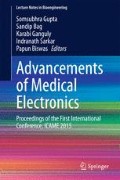Abstract
This paper proposed a method to implement an intelligent system to find out the risk of cardiovascular diseases in human being. Genetics play a direct and indirect role in increasing the risks of cardiovascular diseases. Habits and individual symptom viz. suffering from diabetes, obesity and hypertension also can influence the risk of the said diseases. Excessive energy accumulation in ones body can create fatal problem in health. In this paper, method has been proposed to the proposed to investigate three major factors i.e. family history of CVD, Other diseases and Average Energy Expenditure and find out the of level of risks of cardiovascular diseases.
Access this chapter
Tax calculation will be finalised at checkout
Purchases are for personal use only
References
World Health Organization (2011) Obesity and Overweight. Fact sheet No. 311. http://www.who.int/mediacentre/factsheets/fs311/en/index.html. Accessed 20 Jan 2011
World Health Organization (2002) World health report 2002: reducing risks, Promoting healthy life. WHO, Geneva, 2002
Despres JP, Moorjani S, Lupien PJ, Tremblay A, Adeau A, Bouchard C (2014) Obesity favors apolipoprotein E- and C-III-containing high density lipoprotein subfractions associated with risk of heart disease. J Lipid Res 55(10):2167–2177
Eckel RH, Krauss RM (1998) American heart association call to action obesity as a major risk factor for coronary heart disease. AHA Nutr Committee Circ 97:2099–2100
Hill JO, Prentice AM (1995) Sugar and body weight regulation. Am J Clin Nutr 62(suppl 1):264S–273S
Preuss HG, Zein M, MacArthy P et al (1998) Sugar-induced blood pressure elevations over the lifespan of three substrains of Wistar rats. J Am Coll Nutr 17:36–47
Sherman WM (1995) Metabolism of sugars and physical performance. Am J Clin Nutr 62( suppl):228S–241S
Klungel O, Stricker B, Paes A, Seidell J, Bakker A, Voko Z, Breteler M, Boer A (1999) Excess stroke among hypertensive men and women attributable to undertreatment of hypertension. Stroke 30:1312–1318
Kornegay C, Liao D, Bensen J, Province M, Folsom A, Ellison C (1997) The accuracy of proband-reported family history of stroke: the FHS Study. Am J Epidemiol 145:S82(Abstract)
Hamilton T, Deborah G. Hamilton T, Theodore W. Zderic1 (2007) Role of low energy expenditure and sitting in obesity, metabolic syndrome, type 2 diabetes, and cardiovascular disease. Marc Diabetes 56(11):2655−2667
Morrison AC, Brown A, Kardia SLR, Turner ST, Boerwinkle E (2003) Evaluating the context-dependent effect of family history of stroke in a genome scan for hypertension. Stroke 34:1170–1175. doi:10.1161/01.STR.0000068780.47411.16
Bey L, Hamilton MT (2003) Suppression of skeletal muscle lipoprotein lipase activity during physical inactivity: a molecular reason to maintain daily low-intensity activity. J Physiol 551:673–682
Hamilton MT, Hamilton DG, Zderic TW (2004) Exercise physiology versus inactivity physiology: an essential concept for understanding lipoprotein lipase regulation. Exerc Sport Sci Rev 32:161–166
Zderic TW, Hamilton MT (2006) Physical inactivity amplifies the sensitivity of skeletal muscle to the lipid-induced downregulation of lipoprotein lipase activity. J Appl Physiol 100:249–257
Levine JA, Lanningham-Foster LM, McCrady SK, Krizan AC, Olson LR, Kane PH, Jensen MD, Clark MM (2005) Interindividual variation in posture allocation: possible role in human obesity. Sci 307:584–586
Hennig R, Lømo T (1985) Firing patterns of motor units in normal rats. Nat 314:164–166
Wong L (2011) Some new results and tools for protein function prediction, RNA target site prediction, genotype calling, environmental genomics, and more. J Bioinform Comput Biol 9(6):5−7
Wang JG, Staessen Ja (2000) Genetic polymorphism in the rennin-angiotenisn system:relevance for susceptibility to cardio vascular diseases. Eur J Phamacol 410(2–3):289–302
Morrison AC, Brown A, Kardia SL, Turner ST Boerwinkle E Genetic Epidemiology Network of Arteriopathy (GENOA) Study
Kee F, Tiret L, Robo J, Nicaud V, McCrum E, Evans A, Cambien F (1993) Reliability of reported family history of myocardial infarction. BMJ 307:1528–1530
Bensen J, Liese A, Rushing J, Province M, Folsom A, Rich S, Higgins M (1999) Accuracy of proband reported family history: the NHLBI Family Heart Study (FHS). Genet Epidemiol 17:141–150
Gregersen NT, Chaput JP, Astrup A, Tremblay A (2008) Human Energy Energy expenditure and respiratory diseases: is there a link. Expert Rev Respir Med 2(4):495–503. doi:10.1586/17476348.2.4.495
Morrison AC, Brown A, Kardia SL (2003) Evaluating the context-dependent effect of family history of stroke in a genome scan for hypertension. Stroke 34(5):1170–1175 (Epub 2003 Apr 24)
Morris JN, Heady JA, Raffle PA, Roberts CG, Parks JW (1953) Coronary heart-disease and physical activity of work. Lancet 265:1053–1057
Weller I, Corey P (1998) The impact of excluding non-leisure energy expenditure on the relation between physical activity and mortality in women. Epidemiol 9:632–635
Manini TM, Everhart JE, Patel KV, Schoeller DA, Colbert LH, Visser M, Tylavsky F, Bauer DC, Goodpaster BH, Harris TB (2006) Daily activity energy expenditure and mortality among older adults. JAMA 296:171–179
An Energy Expenditure Estimation Method Based on Heart Rate, Measurement Firstbeat Technologies Ltd
Kruger J, Yore MM, Kohl HW 3rd (2007) 3rd Leisure-time physical activity patterns by weight control status: 1999–2002 NHANES. Med Sci Sports Exerc 39:788–795
Author information
Authors and Affiliations
Corresponding author
Editor information
Editors and Affiliations
Rights and permissions
Copyright information
© 2015 Springer India
About this paper
Cite this paper
Gupta, S., Banerjee, A. (2015). Proposed Intelligent System to Identify the Level of Risk of Cardiovascular Diseases Under the Framework of Bioinformatics. In: Gupta, S., Bag, S., Ganguly, K., Sarkar, I., Biswas, P. (eds) Advancements of Medical Electronics. Lecture Notes in Bioengineering. Springer, New Delhi. https://doi.org/10.1007/978-81-322-2256-9_1
Download citation
DOI: https://doi.org/10.1007/978-81-322-2256-9_1
Published:
Publisher Name: Springer, New Delhi
Print ISBN: 978-81-322-2255-2
Online ISBN: 978-81-322-2256-9
eBook Packages: EngineeringEngineering (R0)

